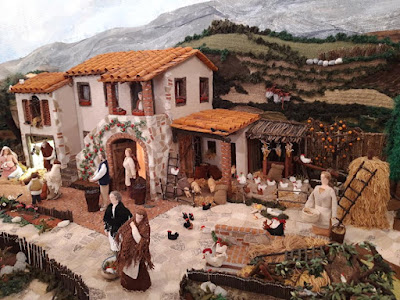 |
picture (December 2022) from the Facebook page of the
Empolese Valdelsa and Montalbano Tourist Area,
between Florence and Pisa: land of art |
In a previous
post attention was paid to a Christmas scene in Italy created by Tiziana Busi, a site located in Pieve di Cento in Italy, decorated with people and buildings made of crochet.
Surprised by the use of crochet, further research into this aspect revealed that there are more crocheted Christmas scenes in Italy. The following post describes the crotched scene created by Gessica Mancini from the community of Cerreto Guidi, a municipality in the metropolitan area of Florence.
Both sites are among the largest creations of Christmas scenes in Italy.
 |
"Le dame dell' uncinetto"
|
Life and works
Born in 1973, Gessica Mancini learned how to crochet at a very young age. She attended the Istituto statale d'arte, a high school that focuses on the fields of culture, art and crafts. Subsequently she worked at a company doing craft carpentry..
Married in 1997, Gessica got three children. In 2013, when she was just 40 years old, a major event occurred in her life: she was diagnosed with Parkinson's disease.
To get away from the thoughts she got because of that diagnosis and to relax a bit, she started crocheting a Christmas scene, because as she said: "When I work for the crib, I don't think about anything and it distracts me from wrong thoughts"
Her choice to make a Christmas scene may also be related to a tradition that from around 2010 was developing in her hometown of Cerreto Guidi: the idea to organize in December as Christmas approaches a competition La via dei Presepi (The Road of the Cribs).
From early December to early January there would be a public display of around a hundred nativity scenes made by private persons, situated along a route in the inner city along shops, libraries and other public places, with a prize for the most beautiful scene.
In 2014, Gessica took part in this competition and with her newly, still small crocheted nativity scene of 1.5 meters she won the first prize.
When making her Christmas crib, she was assisted by some crocheters from the area, this via a call on Facebook.
The first prize encouraged her and the other women involved to continue their creative project and so today (2023) the nativity scene has grown considerably. With a length of 30 m it is one of the largest in Italy
The Christmas scene shows characters and buildings from the community of Cerreto Guidi, as well as scenes of gardens and fields in the rural area around the city.
A striking item is the replica of the 16th century hunting lodge of the Medici family, depicted above and below, with an impressive staircase designed by he 16th century architect Bernardo Buontalenti.
This staircase is composed of 7,000 crocheted stones of 4 cm each, so beautifully made that they look like real stones.

In addition to this famous building, there are replicas of all kinds of historic and other buildings, but also replicas of shops. markets and other public places from the village of Cerreto Guidi, all made with attention to the smallest details and everything rigorously crocheted.
The scenes ar often full of people and one can also meet well-known characters of the community, such as the local priest or the butcher. The scenes of the countryside in the area show vegetable and flower gardens, with fruits and flowers depicted in detail.
A group of some fifty crochet ladies.
The small group of people who had assisted Gessica Mancini in the very beginning, grew over the years. It became an association of more than 50 women, of all ages and living in all kinds of places in Italy.
In consultation with Gessica Mancini they make entire scenes or parts of scenes, such as walls, bricks, parts of the street or certain costumes, which are often sent by parcel post when the contributing lady lives further away.
The association, referred to in Italian as LE DAME DELL'UNCINETT0 (The ladies of crochet) has its own page on Facebook.

A nationwide inventory of Christmas nativity scenes
Italy has a centuries-old tradition of nativity scenes, which began with Saint Francis of Assisi, who created the first nativity scene in history in 1223 in a cave just outside the old hill town of
Greccio in the region of Lazio.
The county has a large number of cities and villages where nativity scenes are installed in public spaces or in churches and other meeting places.
There is now a National Association of Cities of Cribs, chaired by the mayor of Cerreto Guidi. which, at the end of October 2022, together with the Ministry of Culture started mapping cribs in Italy. In addition to data on number and location, the working group, coordinated by the Central Institute for Intangible Heritage of the Ministry of Culture, also investigates immaterial aspects, such as the history of the creation, the skills, knowledge and motivation of the makers and the involvement of local residents.
Wouldn't it be a good idea to start this context in some way a project focused on an investigation of the artistic aspects of Christmas cribs in Italy ?
Documentation*
Facebook-account Le Dame dell'uncinetto, with information about opening days/hours
* Article in travel blog
Amiche in Wanderlust, with a variety of pictures
* Article (November 2021) in newspaper
Valdelsa.net * Article by Margherita Cecchin in newspaper la Repubblica (December 2022)
Videos
* Video on Facebook by Italia on the road with an overview of a large part of the Christmas scene
* Video (2018) on the Facebook page of Le Dame dell' uncinetto
Gessica Mancini
Scena natalizia
Via Santi Saccenti 53
Cerreto Guidi, area of metropolitan Florence, regio Tuscany, Italy
visitors welcome (see FB-page for opening days/hours





























